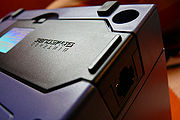
Nintendo GameCube Broadband Adapter
Encyclopedia

Network card
A network interface controller is a computer hardware component that connects a computer to a computer network....
and 56k dial-up
Dial-up access
Dial-up Internet access is a form of Internet access that uses the facilities of the public switched telephone network to establish a dialled connection to an Internet service provider via telephone lines...
modem
Modem
A modem is a device that modulates an analog carrier signal to encode digital information, and also demodulates such a carrier signal to decode the transmitted information. The goal is to produce a signal that can be transmitted easily and decoded to reproduce the original digital data...
, respectively, for the Nintendo GameCube
Nintendo GameCube
The , officially abbreviated to NGC in Japan and GCN in other regions, is a sixth generation video game console released by Nintendo on September 15, 2001 in Japan, November 18, 2001 in North America, May 3, 2002 in Europe, and May 17, 2002 in Australia...
. They were produced by Conexant
Conexant
Conexant Systems, Inc. is an American semiconductor company, formerly the semiconductor division of Rockwell International. Currently it's privately owned by Golden Gate Capital, an equity firm headquartered in San Francisco.-History:...
and made in the Philippines
Philippines
The Philippines , officially known as the Republic of the Philippines , is a country in Southeast Asia in the western Pacific Ocean. To its north across the Luzon Strait lies Taiwan. West across the South China Sea sits Vietnam...
. The adapters fit flush into "Serial Port 1" on the underside of the GameCube and add a 8P8C (RJ-45) or 6P4C (RJ-11
Registered jack
A registered jack is a standardized physical network interface — both jack construction and wiring pattern — for connecting telecommunications or data equipment to a service provided by a local exchange carrier or long distance carrier. The standard designs for these connectors and their wiring...
) port to the side of the console.
Online and LAN play
The adapters enable online play for four titles: Phantasy Star Online Episode I & II, Phantasy Star Online Episode I & II Plus, and Phantasy Star Online Episode III: C.A.R.D. Revolution from SegaSega
, usually styled as SEGA, is a multinational video game software developer and an arcade software and hardware development company headquartered in Ōta, Tokyo, Japan, with various offices around the world...
, and Homeland
Homeland (video game)
is a role-playing video game for the Nintendo GameCube developed by Chunsoft and released in Japan only.The game can be played offline in single-player mode or online in multiplayer mode over the internet or on a LAN. In online mode the player can assume the role of gamemaster and create an online...
from Chunsoft
Chunsoft
is a Japanese video game developer specializing in console RPGs and visual novels. It was founded by Koichi Nakamura, a video game designer from Enix...
, which was only released in Japan.
The broadband adapter allows LAN
Local area network
A local area network is a computer network that interconnects computers in a limited area such as a home, school, computer laboratory, or office building...
play with Mario Kart: Double Dash!!
Mario Kart: Double Dash!!
Mario Kart: Double Dash!! is a racing game developed by Nintendo Entertainment Analysis and Development and published by Nintendo for the Nintendo GameCube in 2003. The game is the fourth installment in the Mario Kart series, following Mario Kart: Super Circuit from 2001...
, Kirby Air Ride
Kirby Air Ride
Kirby Air Ride,or カービィのエアライド in Japan, is a racing game video game developed by HAL Laboratory and published by Nintendo for the Nintendo GameCube video game console starring Kirby, one of HAL's characters....
, and 1080° Avalanche
1080° Avalanche
1080° Avalanche is a snowboarding game for the Nintendo GameCube, developed by Nintendo's in-house development studio, NST, and published by Nintendo. Avalanche is a sequel to 1080° Snowboarding for the Nintendo 64. The game has an emphasis on racing, rather than doing tricks, in contrast to other...
. Warp Pipe and XLink Kai
XLink Kai
XLink Kai is a method developed by Team-XLink for online play of certain compatible console games.It enables players on the Xbox 360, Xbox, Playstation 3, PlayStation 2, PlayStation Portable and Nintendo GameCube to play games across the Internet using a network configuration that simulates a...
have created unofficial tunneling software that allows these games to be played over the Internet.
Possibilities for running unsigned code
Soon after PSO I & II was released for the GameCube, it was discovered that a PCPersonal computer
A personal computer is any general-purpose computer whose size, capabilities, and original sales price make it useful for individuals, and which is intended to be operated directly by an end-user with no intervening computer operator...
could be made to simulate the conditions of the server that the game would connect to. This information started as a method of tunneling
Tunneling protocol
Computer networks use a tunneling protocol when one network protocol encapsulates a different payload protocol...
the online service. When simulating this server, unsigned code can be streamed back to the GameCube, allowing homebrew
Homebrew (video games)
Homebrew is a term frequently applied to video games or other software produced by consumers to target proprietary hardware platforms not typically user-programmable or that use proprietary storage methods...
, or information could be streamed back, allowing one to play copied games. This was also implemented to allow online gameplay in games for which it is not intended. Early dumps of GameCube games were created using this technique. From there, methods of running the games off of a computer through a GameCube were created. Nintendo and Sega responded by releasing the Plus version of the game.

